
Rabbit Anti-NR1H4 antibody
Bile Acid Receptor NR1H4; BAR; FXR; Farnesoid X activated receptor; Farnesoid X receptor; Farnesoid X-activated receptor; Farnesol receptor HRR 1; Farnesol receptor HRR-1; Farnesol receptor HRR1; FXR; HRR 1; HRR1;NR1H4_HUMAN; Nuclear receptor subfamily 1
View History [Clear]
Details
Product Name NR1H4 Chinese Name 胆汁酸受体抗体 Alias Bile Acid Receptor NR1H4; BAR; FXR; Farnesoid X activated receptor; Farnesoid X receptor; Farnesoid X-activated receptor; Farnesol receptor HRR 1; Farnesol receptor HRR-1; Farnesol receptor HRR1; FXR; HRR 1; HRR1;NR1H4_HUMAN; Nuclear receptor subfamily 1 group H member 4; Retinoid X receptor interacting protein 14; Retinoid X receptor-interacting protein 14; RIP 14; RIP14; RXR interacting protein 14; RXR-interacting protein 14. literatures Research Area Tumour Cell biology Signal transduction The new supersedes the old Epigenetics Immunogen Species Rabbit Clonality Polyclonal React Species Human, Mouse, (predicted: Rat, Dog, Pig, Cow, Horse, Sheep, ) Applications WB=1:500-2000 ELISA=1:5000-10000 IHC-P=1:100-500 IHC-F=1:100-500 Flow-Cyt=3ug/test ICC=1:100-500 IF=1:100-500 (Paraffin sections need antigen repair)
not yet tested in other applications.
optimal dilutions/concentrations should be determined by the end user.Theoretical molecular weight 56kDa Cellular localization The nucleus Form Liquid Concentration 1mg/ml immunogen KLH conjugated synthetic peptide derived from human FXR/Bile Acid Receptor NR1H4: 175-280/486 Lsotype IgG Purification affinity purified by Protein A Buffer Solution 0.01M TBS(pH7.4) with 1% BSA, 0.03% Proclin300 and 50% Glycerol. Storage Shipped at 4℃. Store at -20 °C for one year. Avoid repeated freeze/thaw cycles. Attention This product as supplied is intended for research use only, not for use in human, therapeutic or diagnostic applications. PubMed PubMed Product Detail The steroid receptor superfamily acts through direct association with DNA sequences known as hormone response elements (HREs) and binds DNA as either homo- or heterodimers. The promiscuous mediator of heterodimerization, RXR, is the receptor for 9-cis retinoic acid, and dimerizes with VDR, TR, PPAR, and several novel receptors including LXR (also referred to as RLD-1) and FXR. FXR and LXR fall into a category of proteins termed “orphan receptors” because of their lack of a defined function, and in the case of LXR, the lack of a defined ligand. FXR has been shown to bind a class of lipid molecules called farnesoids. LXR/RXR heterodimers have highest affinity for DR-4 DNA elements while FXR/RXR heterodimers bind IR-1 elements. Both LXR/RXR and FXR/RXR heterodimers retain their responsiveness to 9-cis retinoic acid.
Function:
Ligand-activated transcription factor. Receptor for bile acids such as chenodeoxycholic acid, lithocholic acid and deoxycholic acid. Represses the transcription of the cholesterol 7-alpha-hydroxylase gene (CYP7A1) through the induction of NR0B2 or FGF19 expression, via two distinct mechanisms. Activates the intestinal bile acid-binding protein (IBABP). Activates the transcription of bile salt export pump ABCB11 by directly recruiting histone methyltransferase CARM1 to this locus.
Subunit:
eterodimer of NR1H4 and RXR. After activation by agonist binding, interacts with a coactivator, NCOA1 or NCOA2 (By similarity). Interacts with CARM1 and SMARD1.
Subcellular Location:
Nucleus.
Post-translational modifications:
Methylation may increase transactivation of target genes.
Similarity:
Belongs to the nuclear hormone receptor family. NR1 subfamily.
Contains 1 nuclear receptor DNA-binding domain.
SWISS:
Q96RI1
Gene ID:
9971
Database links:Entrez Gene: 9971 Human
Entrez Gene: 20186 Mouse
Omim: 603826 Human
SwissProt: Q96RI1 Human
SwissProt: Q3V1T8 Mouse
SwissProt: Q60641 Mouse
Unigene: 282735 Human
Unigene: 3095 Mouse
Unigene: 42943 Rat
Product Picture
Large intestine (Mouse) Lysate at 40 ug
Primary: Anti-NR1H4 (SL12867R) at 1/300 dilution
Secondary: IRDye800CW Goat Anti-Rabbit IgG at 1/20000 dilution
Predicted band size: 56 kD
Observed band size: 56 kD
Sample:
Lane 1: Mouse Kidney tissue lysates
Lane 2: Mouse Pancreas tissue lysates
Lane 3: Rat Liver tissue lysates
Lane 4: Human HepG2 cell lysates
Lane 5: Human MCF-7 cell lysates
Primary: Anti- NR1H4 (SL12867R) at 1/1000 dilution
Secondary: IRDye800CW Goat Anti-Rabbit IgG at 1/20000 dilution
Predicted band size: 56 kDa
Observed band size: 50 kDa
Sample:
HepG2 (Human) CellLysate at 30 ug
Primary: Anti-NR1H4 (SL12867R) at 1/300 dilution
Secondary: IRDye800CW Goat Anti-Rabbit IgG at 1/20000 dilution
Predicted band size: 56 kD
Observed band size: 56 kD
Sample:
Liver (Mouse) Lysate at 40 ug
Primary: Anti- NR1H4 (SL12867R) at 1/1000 dilution
Secondary: IRDye800CW Goat Anti-Rabbit IgG at 1/20000 dilution
Predicted band size: 56 kD
Observed band size: 56 kD
Sample: HepG2 Cell (Human) Lysate at 40 ug
Primary: Anti-NR1H4 (SL12867R) at 1/300 dilution
Secondary: IRDye800CW Goat Anti-Rabbit IgG at 1/20000 dilution
Predicted band size: 56 kD
Observed band size: 56 kD
Blank control:A549.
Primary Antibody (green line): Rabbit Anti-NR1H4 antibody (SL12867R)
Dilution: 1μg /10^6 cells;
Isotype Control Antibody (orange line): Rabbit IgG .
Secondary Antibody : Goat anti-rabbit IgG-PE
Dilution: 3μg /test.
Protocol
The cells were fixed with 4% PFA (10min at room temperature)and then permeabilized with 90% ice-cold methanol for 20 min at-20℃. The cells were then incubated in 5% BSA to block non-specific protein-protein interactions for 30 min at at room temperature .Cells stained with Primary Antibody for 30 min at room temperature. The secondary antibody used for 40 min at room temperature. Acquisition of 20,000 events was performed.
Bought notes(bought amounts latest0)
No one bought this product
User Comment(Total0User Comment Num)
- No comment
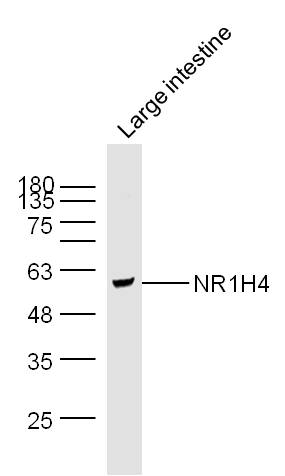
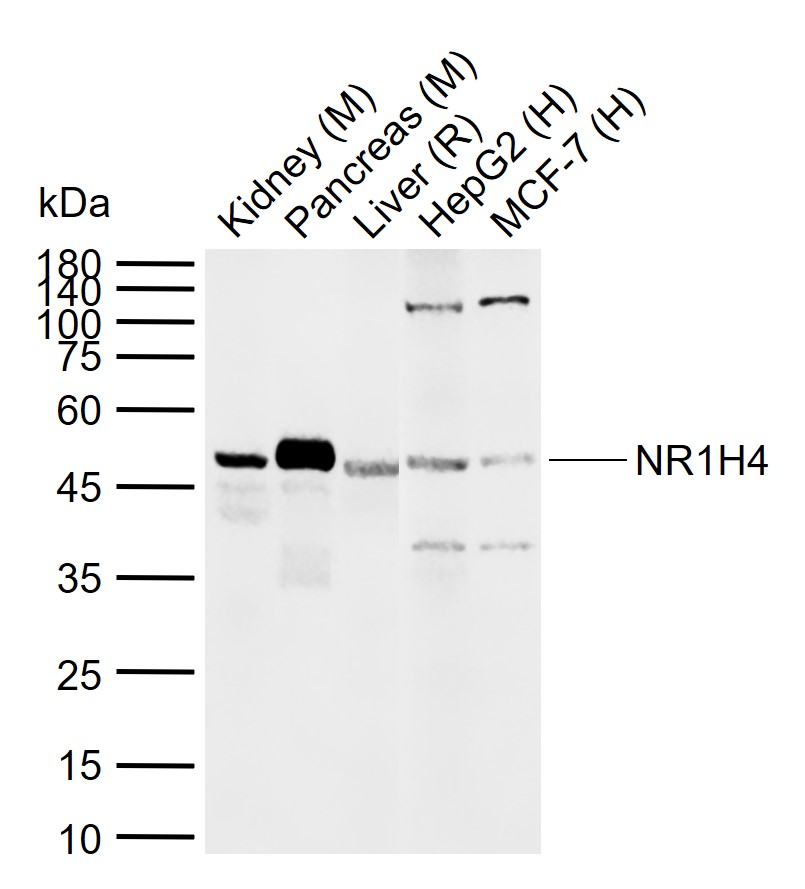
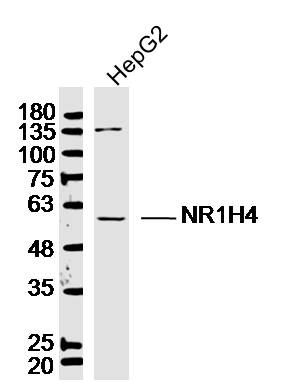
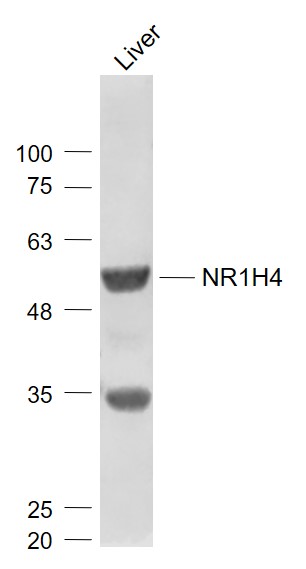
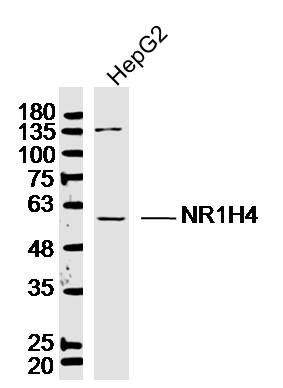
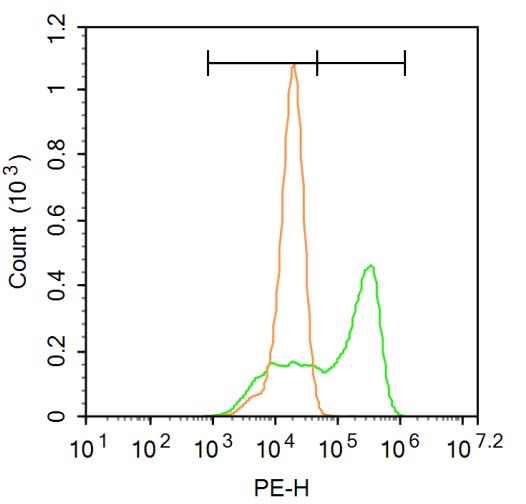


 +86 571 56623320
+86 571 56623320
 +86 18668110335
+86 18668110335

